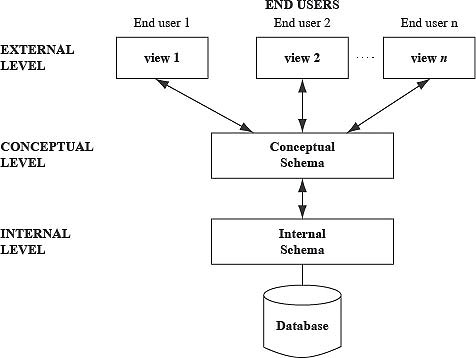
Architecture of DBMS
Table of Content:
The DBMS architecture describes how data in the database are viewed by the users. It is not concerned with how the data are handled and processed by the DBMS. In this architecture, the overall database description can be defined at three levels namely, internal, conceptual and external levels and, thus, named three-level DBMS architecture (Figure below). The three levels are as follows:

Internal level:
It is the lowest level of data abstraction that deals with the physical representation of the database on the computer and, thus, is also known as the physical level. It describes how the data are physically stored and organized on the storage medium.
Conceptual level:
This level of abstraction deals with the logical structure of the entire database and, thus, is also known as the logical level. It describes what data are stored in the database, the relationships among the data and a complete view of the user's requirements without any concern for the physical implementation.
External level:
It is the highest level of abstraction that deals with the user's view of the database and, thus, is also known as the view level. It permits users to access data in a way that is customized according to their needs, so that the same data can be seen by different users in different ways, at the same time. In this way, it provides a powerful and flexible security mechanism by hiding the parts of the database from certain users as the user is not aware of the existence of any attributes that are missing from the view.
These three levels are used to describe the schema of the database at various levels. Thus, the three-level architecture is also known as three-schema architecture.
Advantage of three-schema architecture
The main advantage of three-schema architecture is that it provides data independence. Data independence is the ability to change the schema at one level of the database system without having to change the schema at the other levels. The database users are provided with an abstract view of the data by hiding certain details of how data are physically stored. This enables the users to manipulate the data without worrying about where they are located or how they are actually stored.
Mapping in three-schema architecture.
In three-schema architecture, each user group refers only to its own external view. Whenever a user specifies a request to generate a new external view, the DBMS must transform the request specified at the external level into a request at the conceptual level, and then into a request at the physical level. If the user requests for data retrieval, the data extracted from the database must be presented according to the need of the user. This process of transforming the requests and results between various levels of DBMS architecture is known as mapping.